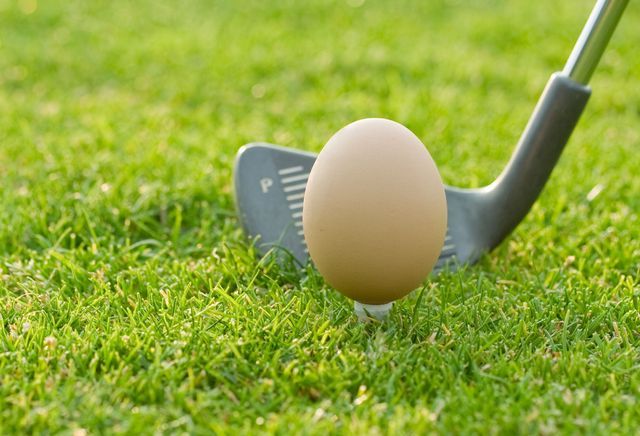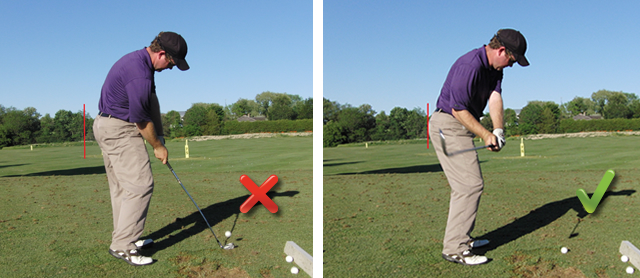In previous articles (check Part 1 and Part 2) we discussed the fact that while all golfers will do everything possible to change their game (buying new clubs and new balls), many overlook one of the most decisive factors for their physical and mental success – their nutrition; we have identified some of the main reasons why golfers never change and, finally, we have pointed out five important links between golf and proper nutrition. In this article, I will share with you my concerns about the so called “normal diet” and the five most important habits you should create to start nourishing your body better.
The Western Diet
The western diet is generally used to describe popular eating habits in the USA. As these eating habits are still very popular in Europe and other parts of the non-Western world, it will probably be necessary to find a new name for this type of “diet” in the coming years (perhaps the killer diet is a good name!).
But what is the “western diet?” Well, this “diet” can be briefly characterized by a high intake of processed foods, refined carbohydrates, sugar and hydrogenated fats; and a low intake of healthy fruits, vegetables and fats. It is this “western diet” that has been associated with most western diseases or diseases of civilization (examples: cardiovascular disease, obesity, diabetes, cancer, Alzheimer, Parkinson). Interestingly, this diet may also be responsible for increased violence and decreased cognitive test scores in school-age children (attention deficit disorder) and adults. Finally, this “western diet” has also been linked to bone loss (osteoporosis) and muscle wasting (sarcopenia) in adult individuals.
Let’s look at an example of a “normal athlete” daily menu before working with me.
Breakfast: Bowl of cereals and milk + Natural orange juice + Coffee with sugar
Snack 1: Mixed toast + Chocolate milk
Lunch: Chicken salad with mayonnaise and ketchup sauce + soda + ice cream
Snack 2: Slice of cake + Juice
Dinner: Grilled fish with vegetables + Baked potatoes + Glass of red wine + Dessert
For most people, this may even be considered a good day (and indeed there are some good things in this menu), but in the long run this type of eating will greatly compromise your health and performance. For this reason, we have to discuss this situation with the person and meet their real physiological and functional needs.
The Habits you must create
Before changing their diet, it is important that people start with a firm and solid foundation, and then make the necessary changes to optimize their health and performance. Most people (athletes included) want to start building a house from the roof down or building walls without paying attention to the quality of the soil. Any of these habits are simple enough, but just like any habit you want to create, it takes time to practice to assimilate the foundations of proper nutrition.
Habit 1 – Drink more water
Sometimes we talk about so much about food and forget about water, the most important element our bodies need to function properly. It is water that regulates all the functions of our body, including the activity of all solutes (the solid materials) dissolved in it. It is water that will actually allow the nutrients we consume to reach our cells and our organs. Aim to consume 1-2 glasses of water after waking up and to drink about 2 liters / day.
Habit 2 – Eat a protein source at every meal
Eating protein at every meal is critical. Of course, some “experts” will make you believe otherwise, suggesting that protein is somehow harmful to the kidneys, unnecessary, etc. However, I want to highlight the fact that what I am looking for my clients / athletes is the best of these three worlds: better health, better body and better performance – it will be very difficult to achieve these three with a suboptimal protein intake. Some examples include: eggs, meat, fish, chicken, turkey and shellfish.
Habit 3 – Eat vegetables at every meal
Your parents and / or grandparents are right – you need to eat vegetables to prevent disease! Evidence has shown that in addition to the micronutrients (vitamins and minerals) contained in vegetables, there are also phytochemicals that are essential for optimal physiological functioning. Vegetables will help improve the acid-base balance in the body, so my advice is eating all the vegetables you can!
Habit 4 – Eat a healthy fat sources at every meal
Fat (such as protein) is an essential macronutrient and so we have to ensure proper intake every day through our diet. There has been a lot of misconception about the effects of fat on diet but the truth is that fat can be our best friend when the goal is to lose fat mass, optimize the body’s physiological response and our health. Some examples of healthy fats include: fatty fish, nuts, seeds, extra virgin olive oil, coconut and avocado.
Habit 5 – Eat more vegetables with main meals and leave the other carbohydrates to the post workout window
Another way of saying this is: if you have fat to lose, you have to earn the right to eat carbohydrates by doing vigorous exercise in the first place! Do you want to keep eating bread, pasta, rice, potatoes, crackers, sugary foods, pizzas, sweets, etc.? You can even eat them – just make sure you do it in the post workout window (1-2 hours after training) because this is the time when your body is most sensitive to insulin. As for the quality of carbohydrates, you will have more benefits if you choose gluten-free foods (rice, quinoa, chestnuts, sweet potatoes, yams, potatoes) than highly processed foods or gluten-free junk foods. Also, don’t use exercise as an excuse to treat your body like the garbage truck!
Good strokes!
Pedro Correia
All golfers have one thing in common: they will invest a lot of time and money to improve their game! They will hire the best coaches to perfect your golf swing. They will buy the best equipment available to get more accuracy and to gain distance. Those who have already realized the importance of fitness in this sport will hire the best professionals to help them gain mobility, become stronger and more resilient. Some will turn to sports psychologists to learn how to maintain a good attitude in the field, focus and concentration. They do all this in order to make more birdies. But aren’t they forgetting something?
In fact, there is something that most golfers forget to change: their low-quality diet. Most golfers have no idea how diet can influence performance. For starters, they forget that eating poorly will compromise increased muscle strength and will lead to body fat accumulation. And if you still think that having weak muscles and excess body fat is the way to go to become a top-level golfer, it’s not worth reading any further. This article is not for you.
In addition to the deleterious effects on body composition and muscle strength it must be borne in mind that eating poorly will limit focus and concentration, will lead to mood swings and may lead to poor immune function, increased chronic inflammation and general health problems. Try playing several rounds for days at a time when you are in a bad mood, in bad shape, and unable to concentrate. Poor nutrition will have a direct impact on training and competition. Lack of focus, concentration and early tiredness, especially during training and / or competitions, are signs that your nutrition is compromising your performance.
No doubt, you can be very skillful with your golf clubs, do some Ballesteros shots and do some exceptional rounds from time to time, but if you’re looking for consistency in results and longevity as a golfer, there’s no better substitute than the foods you eat every day. None!
So why do golfers never change?
There are several reasons why golfers never change and prefer to continue eating the club sandwiches, the chips and the pasta served in every clubhouse menu in the world. Let’s go through some of those reasons.
1) The myth of the pre-competition meal.
Many golfers (especially beginners) make the mistake of thinking that it is only the food eaten before and during practice and competition that can affect their game. While this may make sense at a first glance, this is not physiologically what happens – most of the energy you are using today depends on the nutrients you have eaten (and absorbed) in the last 72 hours!
Please note, I am not saying that what you eat before and after practice / competition makes no difference. Of course it does! However, these meals are not necessarily the most important. Each meal will have a certain impact on your body regardless of the time frame in which it is consumed. It is the cumulative effect of these meals that will lead to an improvement (or decrease) in performance.
In other words, in golf, there is no pre-competition or intra-competition magic meal. If you’ve waited until the day before a big competition to start eating well, it’s probably too late. I am sorry to inform you but there are no miraculous solutions, you really need to eat consistently well!
2) Golfers cannot see the link between nutrition and performance.
Most golfers do not realize the connection between nutrition and performance. And that’s because they are not aware of how diet will influence their muscle function and brain biochemistry.
In the case of golf, as this is a sport that does not involve too much energy expenditure and does not require athletes to maintain a certain body weight (as with wrestlers, gymnasts, swimmers, endurance athletes or athletes from other sports), it is thought that the need to eat well is not that important. In fact, this relationship might not seem so obvious.
But that’s not the point, golfers don’t need to be muscular and low body fat individuals as you see in fitness magazines. What they need is to develop their athletic potential so that this is not a factor that could hinder their performance on the golf course. Golf is not a very energy-intensive sport so a golfer’s nutritional needs cannot match those of a fighter or an endurance athlete. But different does not mean less important – as we saw above it is not just body composition that will be influenced by diet.
Although the link between golf and nutrition is a little less visible than in other sports, it exists. Maintaining and / or increasing muscle mass, mobility, reducing inflammation of muscles and joints, maintaining focus and concentration, preventing injuries, can all be influenced by nutrition. But only those who put the best nutritional strategies into practice will have competitive advantages (obviously this does not include Big Macs!).
3) The difficulty in changing eating habits.
Probably the most difficult hurdle for most people is overcoming the eating habits they have. Our eating patterns have been around for a long time and few people are willing to change them if there is not a strong reason (as in the case of a serious health problem). And why does this happen? Because we have not been taught to think that food is information for our cells. We have not been taught to think that food will influence the expression of our genes. We have not been taught to think that it is the everyday foods we consume from our environment that can trigger health improvement or health deterioration.
Of course there are many other reasons why golfers are reluctant to change their eating habits and why you don’t change yours. And that’s why in the next article I will continue to address this topic so you can understand why you need to change your eating habits quickly to live healthier and to take your game to the next level.
Good strokes!
Pedro Correia
Following up on the topic addressed in the last article, let’s talk today about a common swing characteristic that affects a lot of golfers and that can compromise their swing efficiency and their performance on the golf course: Early Extension.
What is Early Extension?
Early extension can be understood as an integral part of loss of posture, this happens when the player’s hip and spine begin to extend too early in the downswing, i.e. the hips and pelvis move towards the ball in the downswing. In practical terms, if your body is not prepared to perform an efficient golf swing while maintaining good posture throughout the movement, you will end up lifting the upper body (spine) and miss the necessary hip rotation at impact. Your hips play a key role in injury prevention and performance improvement. If you have poor hip mobility, sooner or later your lower back will complain (and you can be sure that this situation will not be very pleasant).
According to studies conducted by the Titleist Performance Institute, 64.3% of amateur golfers early extend
Players who early extend usually refer that they feel trapped during the downswing as if they had to shrug their arms to hit the ball. And it’s normal for that to be so because when you extend your hips too early on the downswing, the space that was supposed to be occupied by your arms and hands was occupied by the lower body. Therefore, the end result will be a blockage of the movement, since your arms and hands can’t get out of the way and will still be needed to hit the ball.
How can I diagnose?
An easy and simple way to check if you do early extension is with your Smart Phone (you probably already have applications that allow you to draw lines and analyze your swing). All you need to do is to ask a friend to film you in the direction of the swing line and capture its full motion from the starting position (setup). After having your swing recorded, compare the position of your pelvis in the initial position with the position of the pelvis in the position of impact, if you notice that it moved towards the direction of the ball is because you extended your hip too early. If this is not possible, you can always ask your golf teacher to help you, I am sure he will be happy to do that.
What are the physical limitations?
“If you’re not assessing, you’re just guessing” – Greg Rose
The physical limitations can be many and to determine the causes that are affecting you, it would be important to make a functional assessment with a professional who understands how your body should move and its relation to the golf swing. According to what I have observed in my practice, I would like to highlight the following:
- Limitations on performing a full squat with the arms extended overhead;
- Limitations in hip mobility (especially in internal rotation of the leading hip and in anterior or posterior pelvic tilt);
- Limitations in the ability to separate / disassociate the thorax from hips (X factor);
- Limitations in the ability to stabilize the pelvis because the glutes and core muscles are inhibited.
What can I do to improve?
Although the causes may vary from person to person, I’m pretty sure that if you do the following exercises, you will improve and increase your body’s functionality to play golf for a longer time. You only need 10 minutes a day.
- Myofascial Release with Roller Stick
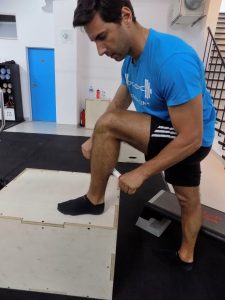
Using a roller stick, look for the trigger points of your calf and massage the inner, central and outer sides of the muscle for 30 seconds in each area. The points that hurt you most are those that need more care. Yes, this exercise might be a little uncomfortable but it’s worth it.
- Glute Bridge with Leg Extension
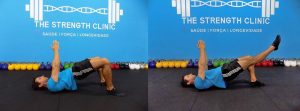
Lying in the supine position, push your heels against the floor, tighten your glutes, and raise your hips to form a glute bridge, with your arms up. Once in this position, extend one leg and form a straight line between the shoulder, hip and heel. Hold this position for 20-30 seconds, always keeping your hips high. Change legs and repeat 5 times on each side.
- Squat with Overhead Arm Reach
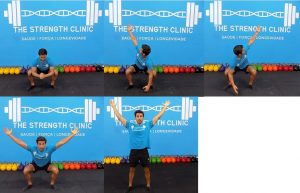
In the squat position (with your heels on the floor and your knees out), raise one arm up, lift the other arm (always looking at your hand) and then raise both arms at the same time and return to the standing position. If you can not squat without raising your heels, you can use a rolled up towel or a board to keep your heels high. Do 2-3 sets and repeat 8-10 times.
- Assisted Squat wiht Medicine Ball
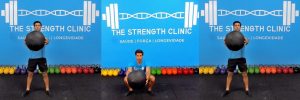
In the standing position, with your feet shoulder-width apart and slightly rotated out, hold a medicine ball (or a bucket full of balls) in front of your body, and begin to slowly lower your body into the squat position by keeping your back straight and without lifting your heels off the floor. Do 2-3 sets and repeat 10-12 times.
I believe that these exercises can be helpful to you, but remember: The swing you can do is directly related to what your body is prepared to do.
See you soon!
Pedro Correia


